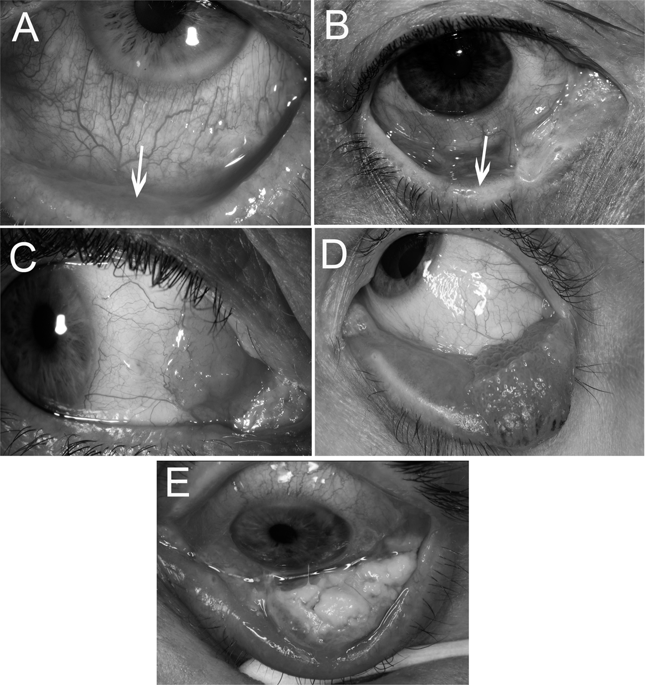当前位置:
X-MOL 学术
›
Modern Pathol.
›
论文详情
Our official English website, www.x-mol.net, welcomes your
feedback! (Note: you will need to create a separate account there.)
Conjunctival 'mucoepidermoid carcinoma' revisited: a revision of terminology, based on morphologic, immunohistochemical and molecular findings of 14 cases, and the 2018 WHO Classification of Tumours of the Eye.
Modern Pathology ( IF 7.1 ) Pub Date : 2020-01-13 , DOI: 10.1038/s41379-020-0456-9 Hardeep S Mudhar 1 , Tatyana Milman 2, 3 , Paul J L Zhang 4 , Carol L Shields 2, 5 , Ralph C Eagle 2, 3 , Sara E Lally 2, 5 , Jerry A Shields 2, 5 , Sachin M Salvi 6 , Paul A Rundle 6 , Jennifer Tan 7 , Ian G Rennie 6
Modern Pathology ( IF 7.1 ) Pub Date : 2020-01-13 , DOI: 10.1038/s41379-020-0456-9 Hardeep S Mudhar 1 , Tatyana Milman 2, 3 , Paul J L Zhang 4 , Carol L Shields 2, 5 , Ralph C Eagle 2, 3 , Sara E Lally 2, 5 , Jerry A Shields 2, 5 , Sachin M Salvi 6 , Paul A Rundle 6 , Jennifer Tan 7 , Ian G Rennie 6
Affiliation

|
In 2018, the consensus meeting for the WHO Classification of Tumours of the Eye decided that conjunctival mucoepidermoid carcinoma should be reclassified as adenosquamous carcinoma, as this represented a better morphological fit. To examine the applicability of this terminology, we studied the clinical, histopathological, immunohistochemical and molecular pathology of 14 cases that were originally diagnosed as conjunctival mucoepidermoid carcinoma. There were 7 (50%) females and 7 (50%) males. The median age was 64 years. The left eye was affected in 8 and the right eye in 6 patients. In-situ carcinoma was present in 11/14 (79%) cases and comprised in-situ squamous cell carcinoma (SCC) and conjunctival intraepithelial neoplasia with mucinous differentiation (CIN-Muc). Invasive carcinoma was present in 11/14 (79%) cases. Group 1 (1/11 cases, 9%) comprised invasive SCC only. Group 2 (6/11 cases, 55%) comprised SCC with mucinous differentiation, manifesting as scattered intracellular mucin, occasionally together with intercellular mucin, with no evidence of true glandular differentiation. Group 3 (3/11 cases. 27%) comprised true adenosquamous carcinoma. Group 4 (1/11 cases, 9%) comprised pure adenocarcinoma. Thirteen of 14 cases (93%) underwent FISH for MAML2 translocation and none were rearranged. Two cases harboured high-risk HPV (type 16 and 18). The combined findings confirm that all lesions in our study were not mucoepidermoid carcinoma, but represented predominantly SCC with mucinous differentiation and adenosquamous carcinoma. We, therefore, recommend future revision of the WHO classification to include SCC with mucinous differentiation alongside adenosquamous carcinoma.
中文翻译:

重新审视结膜“粘液表皮样癌”:根据 14 例病例的形态学、免疫组织化学和分子发现以及 2018 年世界卫生组织眼部肿瘤分类对术语进行修订。
2018年,WHO眼部肿瘤分类共识会议决定将结膜粘液表皮样癌重新归类为腺鳞癌,因为这代表了更好的形态学适应性。为了检查该术语的适用性,我们研究了 14 例最初诊断为结膜粘液表皮样癌的临床、组织病理学、免疫组织化学和分子病理学。有 7 名(50%)女性和 7 名(50%)男性。中位年龄为 64 岁。8 名患者的左眼受到影响,6 名患者的右眼受到影响。原位癌存在于 11/14 (79%) 病例中,包括原位鳞状细胞癌 (SCC) 和结膜上皮内瘤变伴粘液性分化 (CIN-Muc)。11/14 (79%) 例出现浸润性癌。第 1 组(1/11 例,9%)仅包含侵入性 SCC。第2组(6/11例,55%)为黏液性分化的鳞状细胞癌,表现为散在的细胞内黏液,偶尔伴有细胞间黏液,无真正腺体分化的证据。第 3 组(3/11 例。27%)包括真正的腺鳞癌。第 4 组(1/11 例,9%)为纯腺癌。14 例中有 13 例 (93%) 接受了 MAML2 易位的 FISH,没有发生重排。两例携带高危 HPV(16 型和 18 型)。综合研究结果证实,我们研究中的所有病变都不是粘液表皮样癌,而是主要代表具有粘液分化和腺鳞癌的鳞状细胞癌。因此,我们建议未来修订 WHO 分类,将伴粘液性分化的 SCC 与腺鳞癌一起包括在内。
更新日期:2020-01-14
中文翻译:

重新审视结膜“粘液表皮样癌”:根据 14 例病例的形态学、免疫组织化学和分子发现以及 2018 年世界卫生组织眼部肿瘤分类对术语进行修订。
2018年,WHO眼部肿瘤分类共识会议决定将结膜粘液表皮样癌重新归类为腺鳞癌,因为这代表了更好的形态学适应性。为了检查该术语的适用性,我们研究了 14 例最初诊断为结膜粘液表皮样癌的临床、组织病理学、免疫组织化学和分子病理学。有 7 名(50%)女性和 7 名(50%)男性。中位年龄为 64 岁。8 名患者的左眼受到影响,6 名患者的右眼受到影响。原位癌存在于 11/14 (79%) 病例中,包括原位鳞状细胞癌 (SCC) 和结膜上皮内瘤变伴粘液性分化 (CIN-Muc)。11/14 (79%) 例出现浸润性癌。第 1 组(1/11 例,9%)仅包含侵入性 SCC。第2组(6/11例,55%)为黏液性分化的鳞状细胞癌,表现为散在的细胞内黏液,偶尔伴有细胞间黏液,无真正腺体分化的证据。第 3 组(3/11 例。27%)包括真正的腺鳞癌。第 4 组(1/11 例,9%)为纯腺癌。14 例中有 13 例 (93%) 接受了 MAML2 易位的 FISH,没有发生重排。两例携带高危 HPV(16 型和 18 型)。综合研究结果证实,我们研究中的所有病变都不是粘液表皮样癌,而是主要代表具有粘液分化和腺鳞癌的鳞状细胞癌。因此,我们建议未来修订 WHO 分类,将伴粘液性分化的 SCC 与腺鳞癌一起包括在内。











































 京公网安备 11010802027423号
京公网安备 11010802027423号